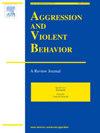Comparing association between traditional-/cyber-bullying perpetration and marijuana use among young people: A systematic review and meta-analysis
IF 3.4
2区 心理学
Q1 CRIMINOLOGY & PENOLOGY
引用次数: 0
Abstract
Although traditional- and cyber-bullying perpetration share similar features, they are also distinguishable and may result in differing impacts on marijuana use among young people. Hence, the current systematic review and meta-analysis aimed to collectively examine the association between bullying perpetrations and young people's marijuana use and to compare their effect sizes. Of the 22 studies included, 33.3 % used a standardized tool for traditional bullying, 33.3 % for cyberbullying, and 9 % for marijuana use. About 36 % estimated the prevalence of marijuana use during the past 30 days, and 63 % measured bullying perpetration without a specified type. Of the 20 studies that examined the association between traditional bullying perpetration and marijuana use, 85.0 % reported a positive association, 10.0 % found no significant relationship, and 5.0 % indicated a negative association. Additionally, all five studies that examined the relationship between cyberbullying perpetration and marijuana use confirmed a significant positive association. The meta-analyses revealed that both traditional bullying and cyberbullying perpetration had an overall effect on marijuana use among young people with the pooled effect sizes at 0.902 and 1.245, respectively, but the effect size for cyberbullying perpetration was larger than traditional bullying perpetration. Comparing these two effect sizes, the strength of association was stronger for cyberbullying perpetration and marijuana use than for traditional bullying perpetration. These findings may reflect a shift in bullying trend from offline to online setting and highlight the potential role of problematic internet use. To address these interconnected issues, the study recommends an integrated, developmentally sensitive intervention model delivered through online platforms.
比较传统/网络欺凌行为与年轻人使用大麻之间的关系:系统回顾和荟萃分析
尽管传统的网络欺凌和网络欺凌行为具有相似的特征,但它们也可以区分开来,并可能对年轻人使用大麻产生不同的影响。因此,当前的系统回顾和荟萃分析旨在共同研究欺凌行为与年轻人使用大麻之间的关系,并比较它们的效应大小。在纳入的22项研究中,33.3%的研究使用标准化工具来应对传统欺凌,33.3%的研究使用网络欺凌,9%的研究使用大麻。大约36%的人估计了过去30天内吸食大麻的流行程度,63%的人测量了没有特定类型的欺凌行为。在调查传统欺凌行为与大麻使用之间关系的20项研究中,85.0%的研究报告了正相关,10.0%的研究发现没有显著关系,5.0%的研究表明存在负相关。此外,所有五项调查网络欺凌行为和大麻使用之间关系的研究都证实了显著的正相关。meta分析发现,传统霸凌行为和网络霸凌行为对青少年大麻使用的总体影响分别为0.902和1.245,但网络霸凌行为的效应量大于传统霸凌行为。比较这两个效应量,网络欺凌行为与大麻使用的关联强度比传统欺凌行为更强。这些发现可能反映了欺凌趋势从线下到线上的转变,并突出了有问题的互联网使用的潜在作用。为了解决这些相互关联的问题,该研究建议通过在线平台提供一种综合的、对发展敏感的干预模式。
本文章由计算机程序翻译,如有差异,请以英文原文为准。
求助全文
约1分钟内获得全文
求助全文
来源期刊

Aggression and Violent Behavior
Multiple-
CiteScore
7.50
自引率
4.30%
发文量
63
期刊介绍:
Aggression and Violent Behavior, A Review Journal is a multidisciplinary journal that publishes substantive and integrative reviews, as well as summary reports of innovative ongoing clinical research programs on a wide range of topics germane to the field of aggression and violent behavior. Papers encompass a large variety of issues, populations, and domains, including homicide (serial, spree, and mass murder: sexual homicide), sexual deviance and assault (rape, serial rape, child molestation, paraphilias), child and youth violence (firesetting, gang violence, juvenile sexual offending), family violence (child physical and sexual abuse, child neglect, incest, spouse and elder abuse), genetic predispositions, and the physiological basis of aggression.
 求助内容:
求助内容: 应助结果提醒方式:
应助结果提醒方式:


